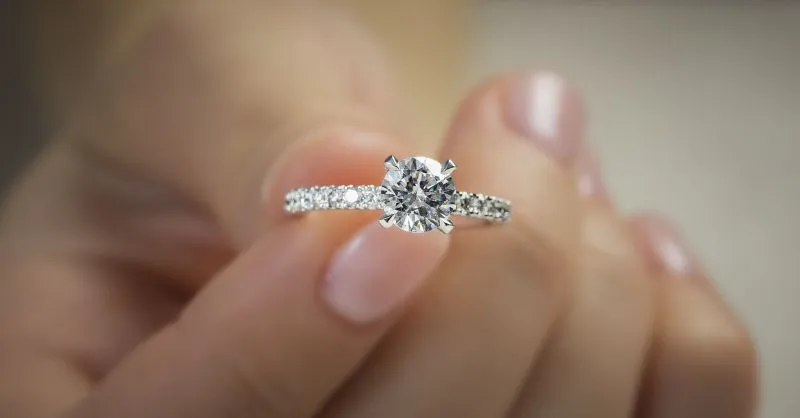Diamonds have long been considered the ultimate symbol of luxury, love, and timeless elegance. Over the years, however, alternatives such as moissanites and man made diamond vs moissanites have gained popularity, offering consumers more choices that align with different budgets, lifestyles, and ethical values. Whether you are shopping for an engagement ring, a special piece of jewelry, or simply exploring gemstone options, understanding the differences between natural diamonds, moissanites, and man made diamonds can help you make a well informed decision.
Table of Contents
Natural Diamonds – The Traditional Choice
Natural diamonds are formed deep within the Earth over billions of years under extreme heat and pressure. These gemstones are composed of pure carbon and are known for their unmatched brilliance, hardness, and durability. They are graded based on the four Cs – cut, color, clarity, and carat weight. Because of their rarity and the intensive mining process, natural diamond vs moissanites often come with a higher price tag.
For many buyers, natural diamonds carry a sense of romance and tradition. However, concerns about ethical sourcing and environmental impact have led some consumers to explore alternatives.
Man Made Diamonds – Lab Created Excellence
Man made diamonds, also known as lab created diamond vs moissanites , are real diamonds that are grown in controlled laboratory environments using advanced technology. They have the same physical, chemical, and optical properties as natural diamonds because they are made of the same material – pure carbon.
The main difference lies in their origin. Instead of being mined from the Earth, man made diamonds are created using methods like High Pressure High Temperature (HPHT) or Chemical Vapor Deposition (CVD). These processes replicate the natural conditions in which diamonds form but take only weeks rather than billions of years.
One of the biggest advantages of man made diamonds is that they tend to cost significantly less than natural diamonds, often by 30 to 40 percent. They are also considered more eco friendly and conflict free, making them an attractive choice for socially conscious buyers.
Moissanites – The Sparkling Alternative
Moissanites are a completely different gemstone, originally discovered in a meteor crater by French scientist Henri Moissan. They are made of silicon carbide and are created in laboratories today for use in jewelry. Moissanites are known for their exceptional sparkle, often displaying more fire or rainbow like flashes of light compared to diamonds.
While moissanites are not diamonds, they are incredibly durable, ranking 9.25 on the Mohs scale of hardness (diamonds are 10). This makes them suitable for everyday wear in engagement rings and other fine jewelry. They are also much more affordable than both natural and man made diamond vs moissanites , making them an appealing option for budget friendly shoppers.
Appearance – How to Tell the Difference
To the untrained eye, diamonds, man made diamonds, and moissanites can look very similar, especially when set in jewelry. However, under magnification or in different lighting, differences become more noticeable. Diamonds have a classic, sharp sparkle with a balance of white and colored light. Moissanites tend to show more colorful flashes, which can appear more dramatic.
Man made diamonds are virtually identical to natural diamonds in appearance since they share the same composition. Even professional jewelers often need specialized equipment to distinguish between the two.
Durability and Longevity
In terms of hardness, diamonds – whether natural or man made – rank 10 on the Mohs scale, making them the hardest known material. This means they are highly resistant to scratching and can last for generations with proper care.
Moissanites are also very durable, second only to diamond vs moissanites , and resist scratching well. However, they may not be quite as tough when it comes to resisting chipping or breaking under extreme pressure compared to diamonds.
Price Differences
Price is one of the most significant factors influencing buyer decisions. Natural diamonds command the highest prices due to their rarity. Man made diamonds offer the same look and feel at a lower cost, while moissanites are generally the most affordable option.
For example, a one carat natural diamond of good quality might cost several thousand dollars. The same size man made diamond could cost noticeably less, while a moissanite of the same size could be just a fraction of that price.
Ethical and Environmental Considerations
The diamond mining industry has faced criticism over environmental damage and labor issues in some regions. While many companies now adhere to the Kimberley Process to reduce the trade of conflict diamonds, some consumers still prefer lab grown options for peace of mind.
Man made diamonds are created in controlled facilities with minimal environmental disruption. Moissanites, being lab created, also have a smaller environmental footprint compared to mined gemstones.
Choosing the Right Stone for You
The choice between diamonds, moissanites, and man made diamonds ultimately comes down to your priorities. If you value tradition, rarity, and the idea of owning a natural gemstone formed over billions of years, a natural diamond may be right for you. If you want the same beauty and durability at a lower cost with a more eco friendly origin, man made diamonds could be the best option. For those seeking maximum sparkle on a budget, moissanites offer impressive brilliance and durability without the higher price tag.
Conclusion
Understanding the differences between diamond vs moissanites , moissanites, and man made diamonds can help you make a confident and informed jewelry purchase. Each option has unique qualities that appeal to different buyers – from the timeless allure of natural diamonds to the ethical and budget friendly benefits of lab created gems. By considering factors such as appearance, durability, price, and sustainability, you can choose the gemstone that best reflects your style, values, and budget.

